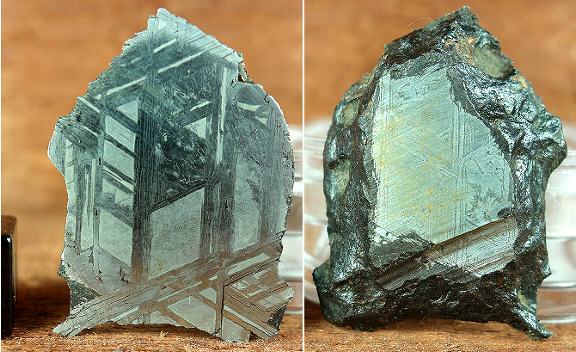NWA 11577
Iron, IAB complex, sHL subgroup
Found December 2016
no coordinates recorded Two iron masses with a combined weight of 86 g were found in Algeria by nomads. The mass was sold to a Moroccan merchant in Ouarzazate who sent a sample to the University of Washington in Seattle (A. Irving) for study; based on a preliminary examination, the iron was determined to be a meteoriteWork in progress. A solid natural object reaching a planet’s surface from interplanetary space. Solid portion of a meteoroid that survives its fall to Earth, or some other body. Meteorites are classified as stony meteorites, iron meteorites, and stony-iron meteorites. These groups are further divided according to their mineralogy and Click on Term to Read More. The main massLargest fragment of a meteorite, typically at the time of recovery. Meteorites are commonly cut, sliced or sometimes broken thus reducing the size of the main mass and the resulting largest specimen is called the "largest known mass". Click on Term to Read More was subsequently purchased by J. Shea, and the initial sample was sent to the University of Alberta (C. Herd) for an in-depth analysis and official classification. Ultimately, NWA 11577 was determined to be a new member of the rare sHL (high-Au, low-Ni) subgroup of the IAB iron complex as defined by Wasson and Kallemeyn (2002). Upon etching, NWA 11577 exhibits a Thomson (Widmanstätten) structure of finest octahedriteMost Common type of iron meteorite, composed mainly of taenite and kamacite and named for the octahedral (eight-sided) shape of the kamacite crystals. When sliced, polished and etched with an acid such as nitric acid, they display a characteristic Widmanstätten pattern. Spaces between larger kamacite and taenite plates are often Click on Term to Read More (Off) texture due to its Ni content of 12.5 wt%.
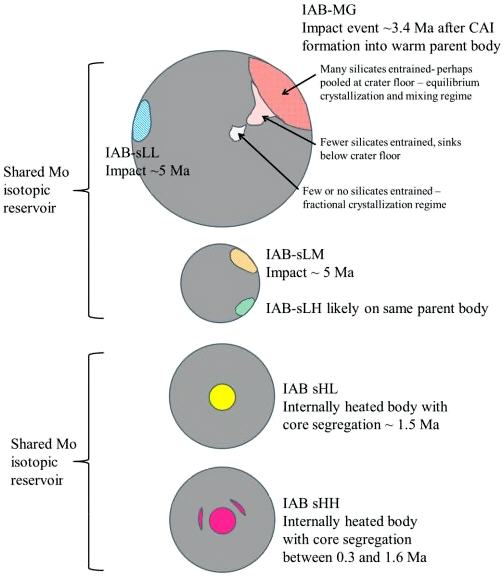
Diagram credit: Worsham et al., Earth and Planetary Science Letters, vol. 467, p. 164 (2017)
‘Characterizing cosmochemical materials with genetic affinities to the Earth: Genetic and chronological diversity within the IAB iron meteoriteIron meteorites consist mostly of metallic iron alloyed with typically between ~5 to ~30 wt% nickel. The main metal phases are kamacite α-(Fe, Ni) and taenite y-(Fe, Ni). Based on their group classification, they may also contain a small weight percentage of one or more of the following minerals: • Click on Term to Read More complex’
(https://doi.org/10.1016/j.epsl.2017.02.044) Employing precise Mo, W, and Os isotope data along with HSE and other literature data, Worsham et al. (2017) ascertained that the two sHL irons in the study (Chebankol and Quarat al Hanish) have indistinguishable µ97Mo isotopic compositions with an average value of 23 (±9). They also demonstrated on a coupled µ97Mo vs. µ189Os diagram that the sHL and sHH subgroups formed in a common reservoir in a spatial and/or temporal aspect. While this reservoir was separated from the other IAB complex irons, all of these irons accreted in the inner region of the protoplanetary cloud. In a broader view, two distinct reservoirs existed in the early protoplanetary disk—carbonaceous chondriteCarbonaceous chondrites represent the most primitive rock samples of our solar system. This rare (less than 5% of all meteorite falls) class of meteorites are a time capsule from the earliest days in the formation of our solar system. They are divided into the following compositional groups that, other than Click on Term to Read More (CC) and non-carbonaceous (NC). These reservoirs were segregated by the rapid accretionAccumulation of smaller objects into progressively larger bodies in the solar nebula leading to the eventual formation of asteroids, planetesimals and planets. The earliest accretion of the smallest particles was due to Van der Waals and electromagnetic forces. Further accretion continued by relatively low-velocity collisions of smaller bodies in the Click on Term to Read More of proto-Jupiter and reflect differences in the contribution (i.e., susceptibility to thermal processing) of p-, r-, and s-process isotopes inherited as dust ejectaFractured and/or molten rocky debris thrown out of a crater during a meteorite impact event, or, alternatively, material, including ash, lapilli, and bombs, erupted from a volcano. Click on Term to Read More from explosive stellar nucleosynthesis (Poole et al., 2017; Bermingham et al., 2018). See diagrams below, where µ notation denotes deviation from terrestrial standards in parts per million. CRE-corrected Mo Isotope Compositions of Meteorite Groups
(µ notation denotes deviation from terrestrial standards in parts per million)
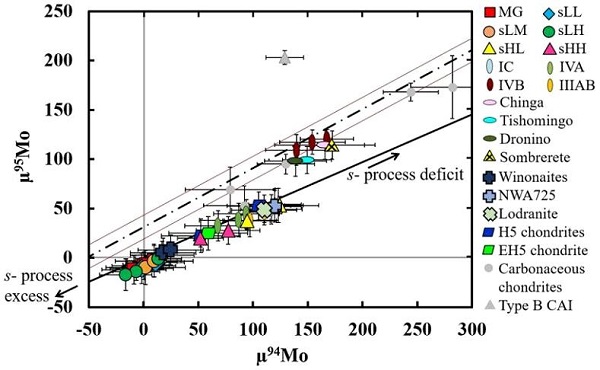
mouseover for alternate view Diagram credit: Worsham et al., Earth and Planetary Science Letters, vol. 467, p. 165 (2017)
‘Characterizing cosmochemical materials with genetic affinities to the Earth: Genetic and chronological diversity within the IAB iron meteorite complex’
(https://doi.org/10.1016/j.epsl.2017.02.044) In another analysis of siderophile elements in IAB irons, Worsham et al. (2016) revealed that the two sHL subgroup irons included in their study, Chebankol and Quarat al Hanish, have HSE patterns broadly similar to late-crystallized IIAB and IIIAB magmatic irons (see diagram below, where Grant (IIIB) is a dashed line and Thurlow (IIIB) is a dash-dotted line). However, based on the dissimilar Pd, Ni, AuThe astronomical unit for length is described as the "mean" distance (average of aphelion and perihelion distances) between the Earth and the Sun. Though most references state the value for 1 AU to be approximately 150 million kilometers, the currently accepted precise value for the AU is 149,597,870.66 km. The Click on Term to Read More, and Ga abundances in these two sHL irons, they concluded that each probably derives from separate parental source melts. It has been demonstrated through Mo- and Os-isotopic analyses that the ungroupedModifying term used to describe meteorites that are mineralogically and/or chemically unique and defy classification into the group or sub-group they most closely resemble. Some examples include Ungrouped Achondrite (achondrite-ung), Ungrouped Chondrite (chondrite-ung), Ungrouped Iron (iron-ung), and Ungrouped Carbonaceous (C-ung). Click on Term to Read More iron Sombrerete, once considered a tentative member of the sHL subgroup, actually formed in the carbonaceous reservoir closely allied with group IVB irons (Worsham et al., 2017).
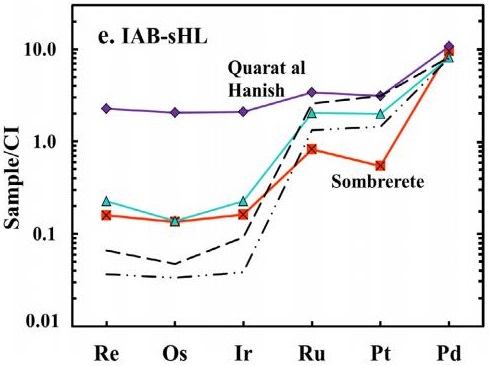
Diagram credit: Worsham et al., GCA, vol. 188, p. 268 (2016)
‘Siderophile elementLiterally, "iron-loving" element that tends to be concentrated in Fe-Ni metal rather than in silicate; these are Fe, Co, Ni, Mo, Re, Au, and PGE. These elements are relatively common in undifferentiated meteorites, and, in differentiated asteroids and planets, are found in the metal-rich cores and, consequently, extremely rare on systematics of IAB complex iron meteorites: New insights into the formation of an enigmatic group’
(https://doi.org/10.1016/j.gca.2016.05.019) To learn more about the relationships that exist among irons of the IAB complex, as well as those for other iron chemical groups, see the Appendix, Part III. The photo shown above is a 13.5 g partial slice of NWA 11577, with both sides beautifully photographed by John Shea. Below is a photo of the two masses of this rare iron.
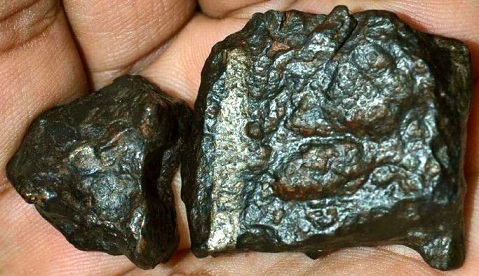
Photo courtesy of John Shea—Big John Meteorites







